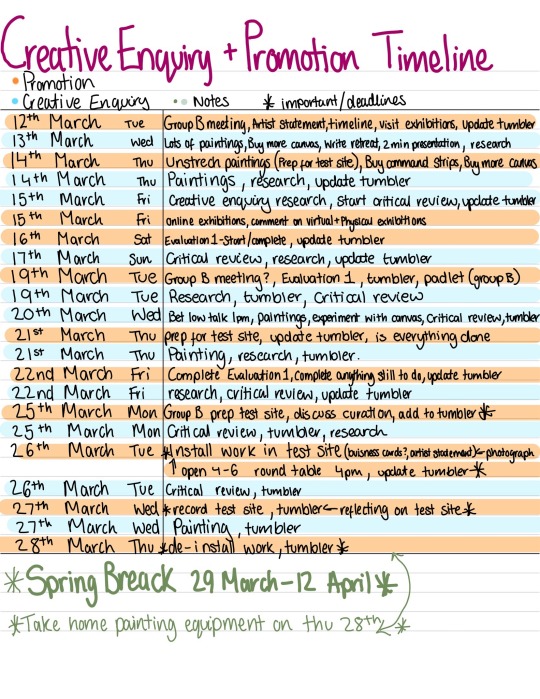Text
The Philosophy of Metaphysics:
Metaphysics was defined by Aristotle during the first century BC. This philosophy communicates ideas surrounding the nature of reality and the possible questioning of nature's structure i.e. sensation, memory, mind, matter, abstraction, space, and time. This usually involves questions that cannot be answered by scientists due to these thoughts and possibilities surrounding existence, and nature, being considered obscure and highly theoretical. It involves the questioning of reality, regarding the possibility of worlds existing outside of ours, as well as the existence of other minds and is often discussed within religion, spirituality, and the occult. I aim for my art to communicate the idea of other worldly phenomenon such as ghosts or demons, hopefully enticing similar questions and conversation relating to metaphysics. Do ghosts and demons exists? If so, what do they look like? What are they capable of? If they do exist, what else may exist within our world?
0 notes
Text
Julia Kristeva's 'Power of Horror':
Julia Kristeva’s ‘Power of Horror’ discusses the idea of the abject and how this may cause intense reactions within oneself, both physically, emotionally, and mentally. A lot of her discussion involves the idea that something could evoke us to question our cleanliness and propriety. Artworks, photos etc that involve bodily fluids or aspects that breakdown the boundaries of inside and outside. However in this case, in relation to my work I am interested in her discussion of the idea that something can be very intense, unfamiliar, scary, and fascinating, in turn unsettling oneself and creating an eerie atmosphere within the viewer. I aim for my works to make my viewer cower away with fear and uncertainty due to the feelings of discomfort evoked through the depiction of dark, sinister and unnatural looking figures.
0 notes
Text
Visual inspiration/ ideas

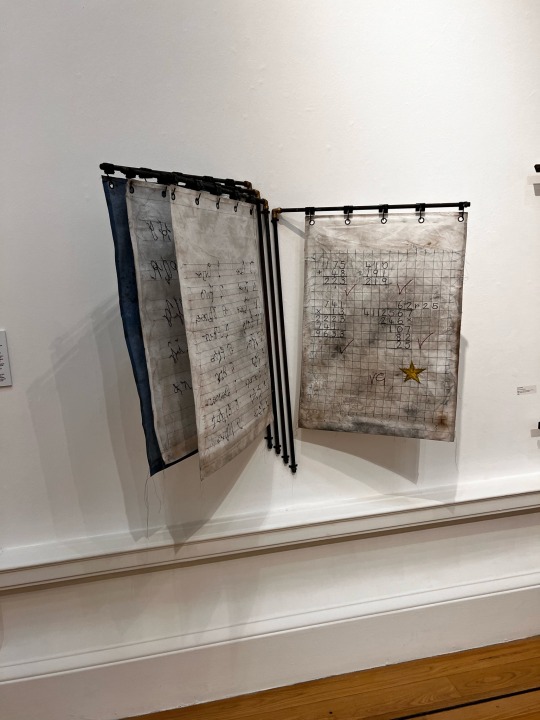
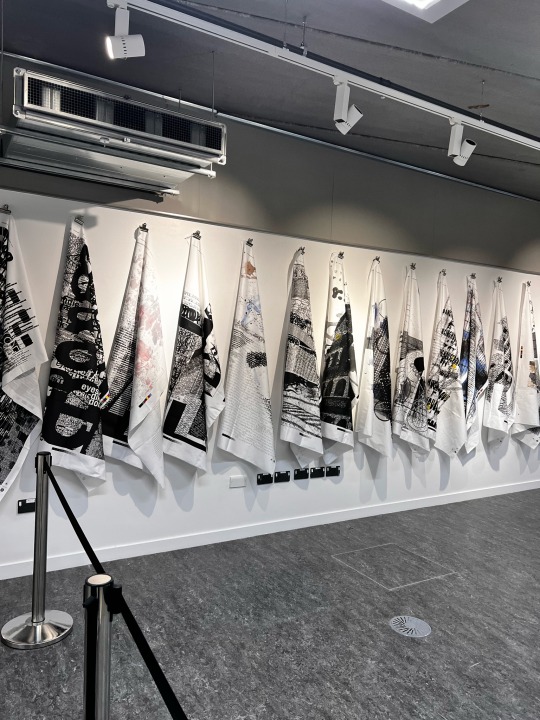


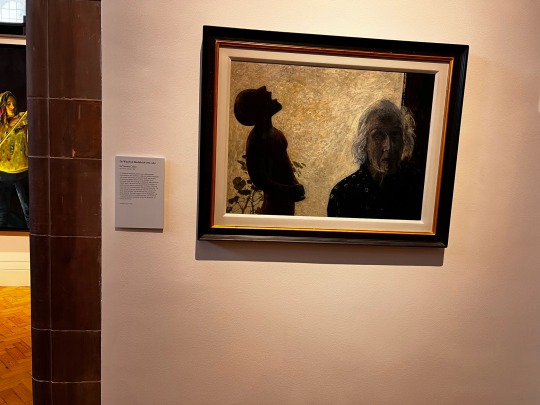

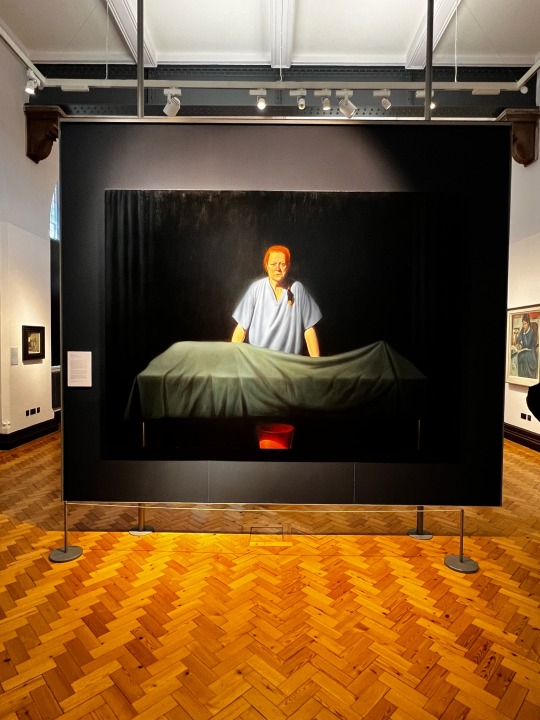
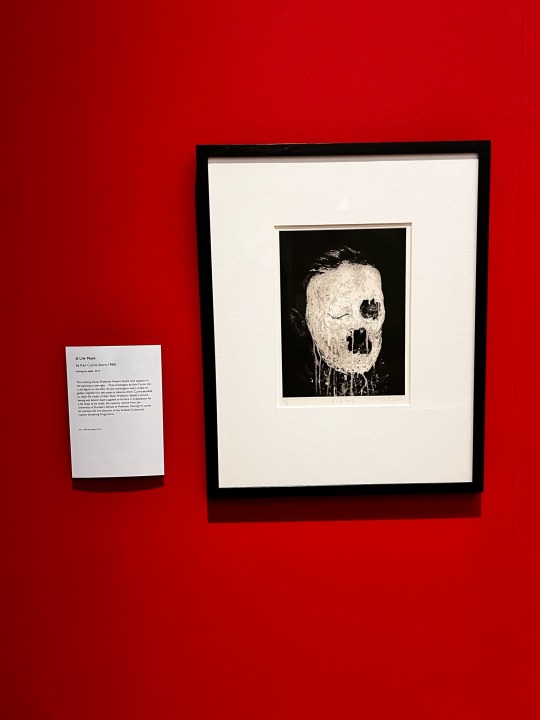

All of these works except the third and fourth pieces are from galleries. The the third and fourth works are from the 7th floor gallery space within the college. The 1st, 3rd and fourth works influence my ideas of how I can display my paintings in an unconventional way. The 2nd artwork reminds me of the ideas that I have for displaying my paintings that on canvas board. I plan to attach them to a hinges to screw onto wooden stands. The way these pieces move are similar to the ways my works will be able to move. The other works contained in this post involve artists that have used similar painting techniques to the ones I incorporate into my practice i.e. dripping and dropping paint or water, sgraffito, distortion technique as well as depicting chilling and eerie subject matters.
0 notes
Text
Critical Review :
Emma Smyth Creative Enquiry Critical Review
4th year BA(Hons) CAP 2024
Throughout this project, I have explored the idea of shadow figure phenomenon through a surrealist approach to my painting process. I aimed to capture these sinister, monster like figures through experimenting with a range of painting techniques and scale. I have always been drawn towards the other worldly and darker aspects of life and our imagination. It is an outlet for my imagination whilst unsettling the viewer and enticing feelings similar to when watching a horror movie. I have been inspired by many artists, theories, art movements and horror movie imagery, but most importantly my own imagination.
At first, I aimed to convey the idea of shadow figure phenomenon whilst evoking fear, uncertainty, and discomfort within the viewer. Shadow figures may be a paranormal phenomenon, for example a ghost or even a demon, lost souls trapped or beings from an inter-dimensional plane. These figures may move quickly, appear as solid shapes, swirling smoke and have a similar appearance to humans. We can usually see them at the corner of our eyes for a fleeting time before they disappear leaving us scared, perplexed and uncomfortable. However, from a scientific point of view, they are viewed as shapes that appear due to a lack of light and occurs due to our eyes simply trying to fill in the blanks (Haunted Rooms®, 2016).
As my practice developed, I realised that my works depict sinister and ambiguous characters, rather than only shadow figures. This fuelled my imagination giving me the confidence and ideas needed to produce more works whilst experimenting with unfamiliar painting techniques.
The Creative Enquiry project has allowed me to experiment and strengthen my painting skills. I found the process very daunting at the beginning, however I embraced the discomfort and continued to make. I realised that I do not need to overthink my paintings and strive for a refined finish, but instead allow myself to be more relaxed by handing control over to my materials through the use of specific techniques. The eerie images came very naturally and instantaneously at first with a surrealist approach. However, it became challenging and frustrating to visualise these sinister characters. I therefore engaged with new techniques of painting, such as “un-painting.” This technique involved applying acrylic to the canvas and using water to lift the colour before the painting dried. I used a spray bottle, allowing the water to take control over the movement of the paint and overall appearance of my works allowing them to become more ambiguous. I incorporated other techniques that worked for my concept into my practice; limited colour palette, sgraffito, dripping, lifting paint with water and using other tools such as squeegees, a hard bristle brush and a variety of paintbrushes. The techniques and ways of working enhanced my paintings by taking them to another level of ambiguity due to the unfinished and abstract appearance, creating a stronger element of fear and uncertainty within the viewer.
I will continue to produce as many paintings as I can and experiment with ways of displaying them. I aim to un-stretch many of my canvases and arrange them in a slumped manner over handmade black wooden stands. This will hopefully remind the viewer of experiences where they have seen an item of clothing hung on a door, in the dark and thought it may be something more sinister and un-welcoming. Through researching installation art, I have decided to arrange my work in a way that allows the audience to engage and interact with my paintings by walking around the stands. The viewers will hopefully be able to see my slumped paintings in their peripheral vision no matter where they situate themselves, hopefully conveying the idea of shadow figures.
Throughout this project I have struggled with self-confidence within my artistic abilities. I chose to paint on large scale canvases, which is not something I have a lot of experience with when undertaking the stretching process. This involves the wood workshop, an environment I am not familiar with, in turn pushing myself out of my comfort zone.
Metaphysics was defined by Aristotle and communicates ideas surrounding the nature of reality and the possible questioning of nature's structure i.e. sensation, memory, mind, matter, abstraction, space, and time. This usually involves questions that cannot be answered by scientists due to these thoughts and possibilities surrounding existence, and nature, being considered obscure and highly theoretical. It involves the questioning of reality, regarding the possibility of worlds existing outside of ours, as well as the existence of other minds and is often discussed within religion, spirituality, and the occult (www.encyclopedia.com, n.d.). My art communicates the idea of other worldly phenomenon such as ghosts or demons, hopefully enticing similar questions and conversation relating to metaphysics. Do ghosts and demons exists? If so, what do they look like? What are they capable of?
Julia Kristeva’s ‘Power of Horror’ discusses the idea of the abject and how this may cause intense reactions within oneself, both physically, emotionally, and mentally. Something can be very intense, unfamiliar, scary, and fascinating, in turn unsettling oneself and creating an eerie atmosphere within the viewer (Kristeva, 1982). The faces within my paintings are unusual and unfamiliar due to the exaggerated facial features, such as extremely high cheek bones, sharp teeth, and gaping mouths. They are uncanny giving you shivers and create an eerie atmosphere, which may cause the viewer to feel uneasy when engaging with my work. Moreover, the theory of the uncanny discovered by Sigmund Freud is the idea that something, for example, a robot is human like and familiar, but also different and not quite right. This in turn allows the object or thing to become unfamiliar creating feelings of uncertainty and discomfort (Ruers, 2019).
The surrealist art movement, pioneered by Karl Marx, has informed, and influenced my practice. Marx aimed to explore the unconscious mind allowing our abilities within our imagination to surface and bring our visions and thoughts to life through our art (The Art Story, 2011). Similarly, I delve into my imagination uncovering images that I can depict through my paintings. The images I conjure are not seen in everyday life and may remind the viewer of their distorted fears and evoke feelings like ones experienced when watching a horror movie. My works involve intense facial expressions and features, unnatural round eyes and colours creating a dreamlike or nightmarish image.
I have found that the techniques used within my works create similar imagery to the figure seen depicted on the front cover of the horror movie Sinister directed by Scott Derrickson. The front cover depicts the main antagonist, 'The Boogie Man' in red substance, on a wall. This blood like substance drips to the floor creating a haunting, and abstract image. By spraying water onto my painting, this creates a similar appearance to the movie imagery. Recognising these connections between my art and the movie imagery, my work becomes even darker and unsettling.
My paintings have been inspired by many artists and their ways of working. Such as, Francis Bacon, who was involved with surrealism before creating works focusing on conveying motion and emotion. The imagery created within his work Study after Velazquez Portrait of Pope Innocent X is dark and haunting due to the gaping mouth of the subject's facial expression. The violent downward brushstrokes enhance the sinister atmosphere created by the unnatural and ghostly facial expression of the figure (The Art Story, 2010). Similarly, Edvard Munch’s The Scream, 1893 depicts a screaming figure with a wide gaping mouth. The figure resides on a bridge surrounded by warm lively strokes of colour conveying a hellish coloured sky, creating a chilling atmosphere (The Art Story, n.d). There are times within my practice that I have depicted figures with gaping mouths. I use lively brushstrokes and distortion techniques to convey motion and the idea of fleeting figures moving in the night.
Artist, Callum Innes, creates abstract works by painting the surface with a variety of pigments before removing layers and sections with turpentine. The artist does not have control over the finished appearance of his works due to the ‘un-painting’ technique (Ingleby Gallery, n.d). Recently within my practice I have utilised an ‘un-painting' technique by using water to lift the acrylic and allowing the water to drip down the canvas, giving control to my materials. These techniques have been successful in enhancing the sinister and haunting atmosphere within my works due to them becoming more unrefined and natural. Scottish artist, Ken Currie creates unsettling, eerie, uncanny, and figurative works that hold a cold atmosphere whilst depicting luminescent masks positioned, almost floating in the middle of the painting surrounded by darkness (Normand, 2002). The figures within my paintings seem to float or reside in the centre of the canvas whilst surrounded by darkness creating a ghostly or even demonic like appearance. I also utilised a limited colour pallet within my practice; I made use of cobalt blue, burgundy, green, red, and black. Although limited, I developed onto use other colours as I felt that limiting my colour pallet further to; black, burnt umber, and red, would enhance the ambiguity as well as create a darker and more nightmare like atmosphere.
Overall, this project has improved my painting skills as well as bring attention to my abilities, and weaknesses. So far, I have achieved more than I expected through the experimentation of painterly techniques and continuous development of my ideas. I had an intention of what I wanted my works to communicate, and I feel I have achieved this. By experimenting with unconventional ways of displaying my paintings this further enhances and communicates my sinister and unsettling works. I have undertaken extensive research that plays a significant role in influencing my overall ideas and will continue to plan and remain organised throughout the creative enquiry project.
Bibliography
Haunted Rooms®. (2016). Shadow People 101 - What Are They, What Do they Look Like? [online] Available at: https://www.hauntedrooms.co.uk/what-are-shadow-people.
Ingleby Gallery. (n.d.). Callum Innes - Overview. [online] Available at: https://www.inglebygallery.com/artists/44-callum-innes/overview/.
jude-white-a2-media. (n.d.). Horror Iconography. [online] Available at: https://chalky500.wixsite.com/jude-white-a2-media/horror-iconography#:~:text=Children [Accessed 6 Apr. 2024].
Kristeva, J. (1982). Powers of Horror an Essay on Abjection. New York, Ny Columbia Univ. Press.
www.encyclopedia.com. (n.d.). Metaphysics, History of | Encyclopedia.com. [online] Available at: https://www.encyclopedia.com/humanities/encyclopedias-almanacs-transcripts-and-maps/metaphysics-history#:~:text=as%20a%20blueprint.- [Accessed 16 Apr. 2024].
Normand, T. (2002). Ken Currie. Ben Uri Gallery & Museum.
Ruers, J. (2019). The Uncanny | Freud Museum London. [online] Freud Museum London. Available at: https://www.freud.org.uk/2019/09/18/the-uncanny/.
Sleep Foundation. (2021). What Are Waking Dreams? [online] Available at: https://www.sleepfoundation.org/how-sleep-works/hypnagogic-hallucinations.
The Art Story. (n.d.). Edvard Munch Paintings, Bio, Ideas. [online] Available at: https://www.theartstory.org/amp/artist/munch-edvard/.
The Art Story (2010). Francis Bacon. [online] The Art Story. Available at: https://www.theartstory.org/artist/bacon-francis/.
The Art Story. (2019). Metaphysical Painting Movement Overview. [online] Available at: https://www.theartstory.org/movement/metaphysical-painting/.
The Art Story (2011). Surrealism Movement Overview. [online] The Art Story. Available at: https://www.theartstory.org/movement/surrealism/.
0 notes
Text
Artist statement:
Word count: 134
Within my artistic practice I visualise sinister faces inspired by shapes that form within the dark and horror movie imagery. I create these monsters to evoke fear and discomfort within the viewer, whilst enticing feelings of uncertainty due to the ambiguous imagery. I experiment with scale, a variety of painting techniques and ways to display my paintings in an unconventional manner. Therefore, to enhance this sinister and ambiguous atmosphere within my work, my paintings have been displayed draped over handmade, black wooden stands and one holds plantings created on canvas board connected with black hinges. They have been arranged in a way that allows the viewer to catch a glimpse of my paintings in their peripheral vision no matter where they situate themselves, in turn evoking similar feelings experienced when encountering a fleeting shadow.
0 notes
Text
Callum Innes:
-Innes was born in 1962 in Edinburgh, Scotland.
-The artist studied at Gray's School of Art in Aberdeen, Scotland as well as studying at the Edinburgh College of Art.
-Innes was awarded the NatWest Prize of Painting in 1998 and was also awarded the Jerwood Prize for painting.
-His work is displayed in many galleries around the world including: Guggenheim, New York, National Gallery of Australia.
-Innes's works are also displayed closer to home at the TATE London and The Scottish Gallery of Modern Art.
-Innes had an exhibition showcasing his work at the Fruitmarket Gallery within Edinburgh during the year 2006.
-Inness utilises many ways of working within his artistic process that actively change within every individual piece that he creates.
-Known for his Exposed Paintings series that involve the layering of different pigments on to his canvas before removing sections of the paint using turpentine. This technique is also seen within his Agitated Verticals, Resonance, Isolated Forms and Monologue artworks.
-there is a lot of uncertainty within Innes's artistic process due to the painting and un-painting as he does not have complete control over what the turpentine may do to the pigments.
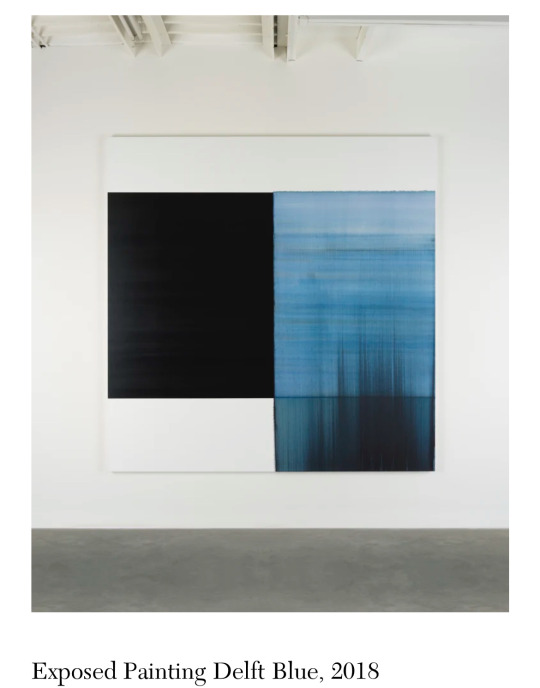

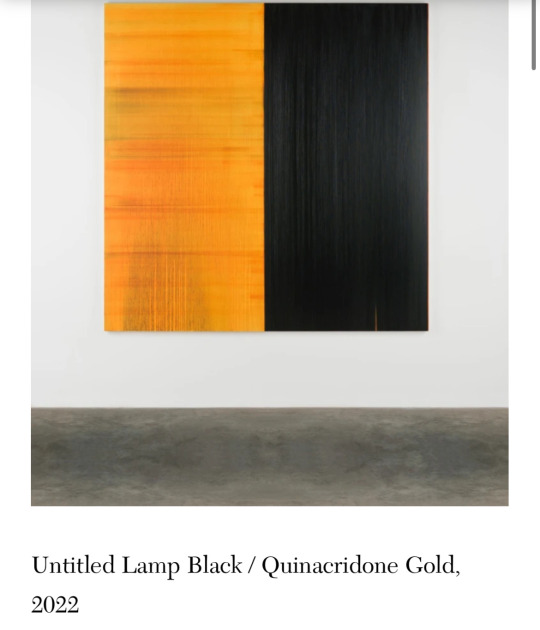
How does this relate to my work?:
Recently my painting style has developed and changed, but still conveying the same concept of sinister characters.
Within this new painting style I have started off by painting a base, usually a mix of black and burnt umber onto the canvas and letting it dry ever so slightly. I then lift or “in-paint” much like Innes, by using a spray bottle with water creating a very distorted and ghostly figure.
0 notes
Text
Gerard Richter:
-Gerhard Richter is a German painter who was born on the 9th of February, 1932 in Dresden.
-Some of Richter's family members were directly involved with Nazi movement, specifically his father, school teacher and uncle.
-At the age of 16 left his education and began an apprenticeship as a set painter within theatres.
-The second World War effected the young artist on a personal level as he lost family members. This lead Richter to pursue his art whilst being inspired by nature rather than political, religious or philosophical issues.
-In 1951, Richter began his studies at Kunstakademie in Dresden. During this time the artist spent is time creating murals and political banners that were supported and requested by state-owned businesses.
-Richter became aware of the artists Jackson Pollock and Lucio Fontana, which in turn informed Richter's artistic practice as he began experimenting with splashes of colour with lots of energy and truth.
-In 1961, before events relating to the Berlin Wall, Richter moved to Dusseldorf and returned to the local Kunstakademie.
-Upon reflecting on his artistic practice, Richter decided he would produce and engage with work that was within the avant-garde style. Therefore, as a result the artist destroyed and discarded many of his earlier works from the 1950s and the 1960s.
-Richter would make use of photograph whilst projecting and tracing images onto his canvases and then paint. The final result was always a distorted and blurred version, therefore creating mystery of what the subject actually looks like.
-Richter's painting style evoked such questions involving components of paintings within the viewers; composition, colour scheme. This allowed the viewer to focus on the elements and literal marks left during the process of painting rather than specific and recognisable features of the subject matters.
-Richter began adopting techniques of blurring, sgraffito, impasto and creating multiple layers within his paintings. He would also used tools other than paint brushes, for example, a squeegee in order to engage with aggressive sweeping motions.
-The artist became a professor at the Kunstakademie in Dusseldorf.
-Richter unfortunately received a lot of criticism for many of his artistic process and actively disregarding the social and political issues that arose at the time due to the World War 2 Nazi regime.
-Later in Richter's artist career, he focused on creating figurative work that captured the imagery of victims that were involved with terrorist attacks.
-Richter continues to maintain his professorship at the Kunstakamedie in Dusseldorf.
-Richter was involved with capitalist realism, pop art and postmodernism.
-The artists paintings explore the idea of capturing images in ways that prove and change the view or overall perception of the object.
-Experiments with realism and abstract art within his paintings.
-the artist was also inspired by minimalism and conceptualism.
-Richter has explored the possibilities of painting and images and their not so good connections with photography.
-He believes that photographs do not convey objects in their entirety.
-His paintings are drawn from the imagery of newspapers or family albums.
-Richter believes that all forms of imagery work alongside one another and communicate.
-for many of his paintings Richter would capture the subject by blurring them convey the extent in which artists can paint something without revealing it truthfully.
-The artists displays his expressive strengths and shortcomings.
-His paintings have many layers, brushstrokes (in lots of directions), colours, with the use of sgraffito and strokes.
-Richter was influenced by artist and influenced artists: Christopher wool, Ellsworth Kelly, Max Beckham, Jackson Pollock, Lucio Fontana, Robert Raushenberg and Andy Warhol.
-Richter had personal connections with artist Sigmar Polke, Blinky Palermo, Robert Storr, Joseph Beuys, George Baselitz and Konrad Fischer-Lueg.
-was influenced by conceptual art and minimalism.
-influenced Pop Art, Abstract Expressionism, Fluxus and Dada




How does this relate to my work?:
Within my practice I will be making use of similar techniques to convey the amount of energy I physically put into my work. I have made use of a squeegee in order to create a distorted and blurred look to many of my sinister subject matters. I have also made use of sgraffito and impasto much like Richter. The techniques he uses to create his works have inspired some of my works.
0 notes
Text
George Martin: visual inspiration

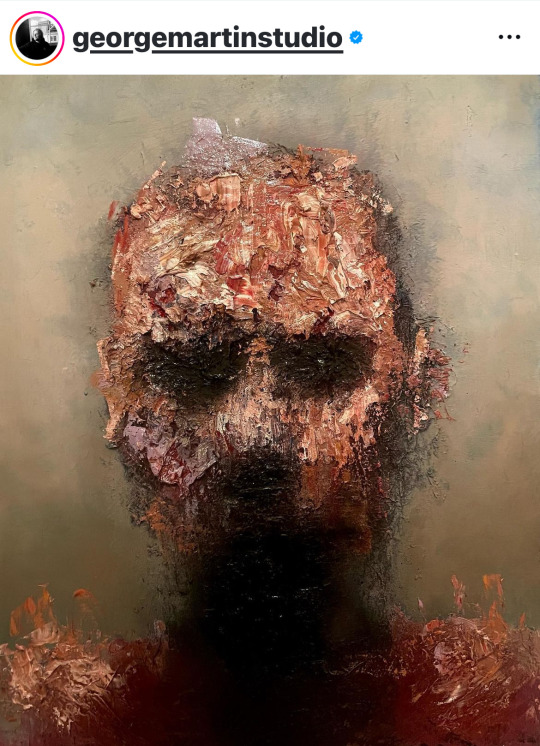

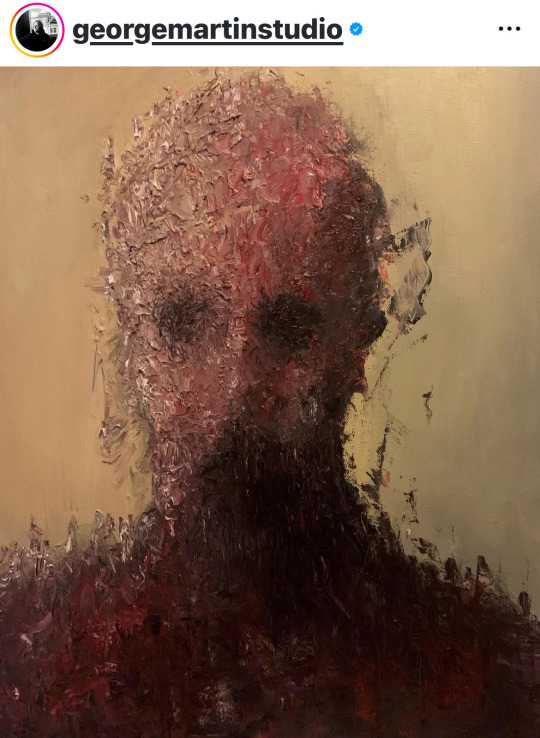
The imagery within these works are ambiguous due to the thickly applied paint affectively distorting the figure. The hollow appearance of the eye sockets create a very sinister, cold and unsettling feeling. Many of my works have a similar imagery.
0 notes
Text
Phillipe Rodrigue: visual inspiration
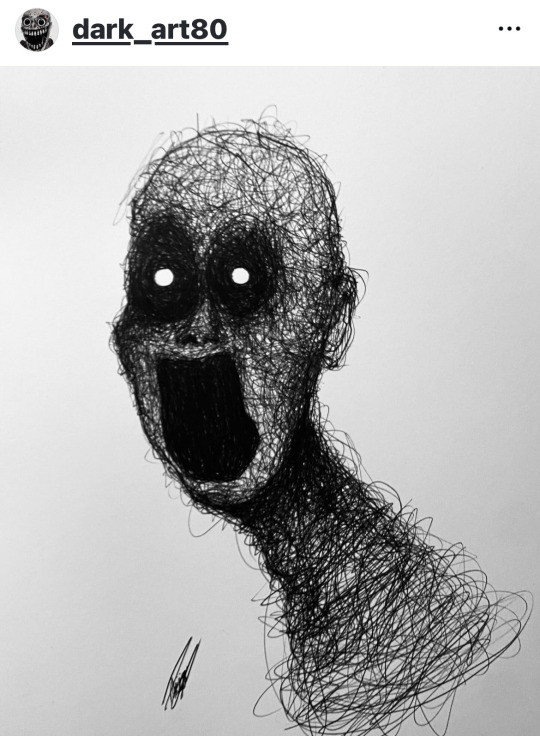

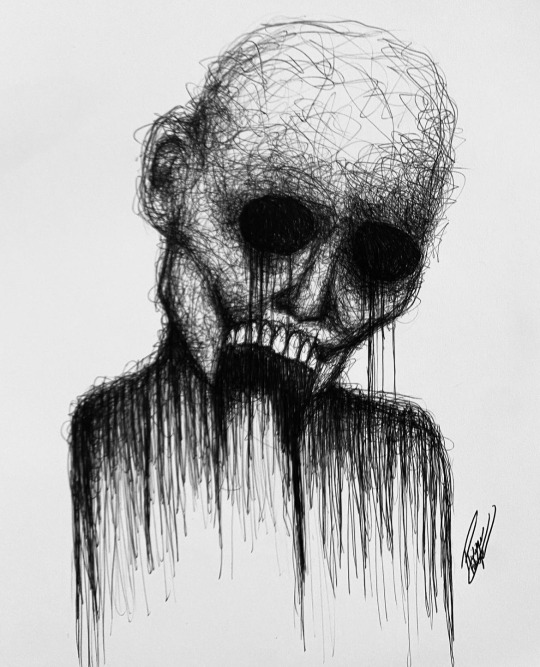

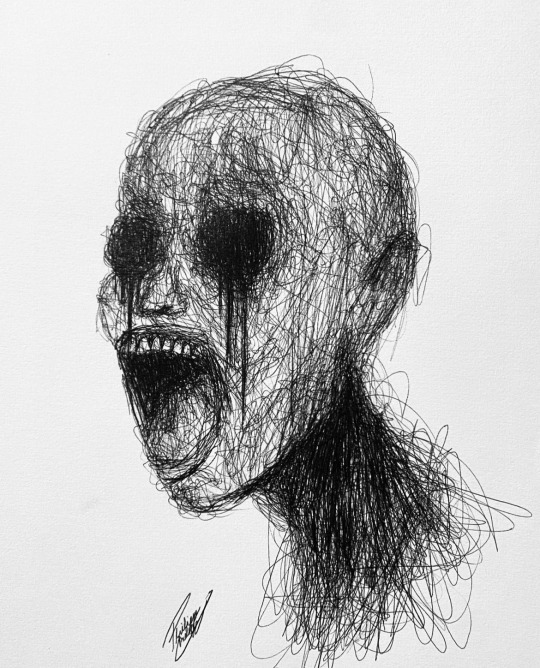
This is another artist that I came across on Instagram that resonated with me. The imagery within these works are very sinister and the facial expressions of these figures are very similar to the faces I envision in my head that inspire my paintings. The movement created with the ink marks create a very sinister atmosphere possibly conveying certain feelings of insanity. The quick movements of the medium used are similar to the ways in which I create my paintings, recently with my art work I have had to work very quickly due to the mediums and techniques i have adopted into my practice.
0 notes
Text
Why do we see scary faces in our dreams:
-Hypnagogic hallucinations may be experienced when someone is in the stage of falling asleep.
-The hallucinations may be visual, sound and possibly physical.
-Hallucinations can be very realistic causing intense reactions from the one experiencing them.
-Hallucinations cannot cause harm to the person experiencing them and can be caused by stress, lack of sleep and tacking certain medication.
-They may evoke fear and cinfussion.
-Hypnagogic hallucinations can be a symptom of narcolepsy, however is not always the case.
-many may see faces, moving patterns, animals, or shapes.
-Many may hear things and physical feel sensations in the body.
-Hypnagogic hallucinations are different from mental health disorders such as Schizophrenia. They are also different from nightmares.
-many who experience these hypnagogic hallucinations do not remember what they see or hear.
-These types of hallucinations are different from sleep paralysis.
How does this link to my work?:
When creating my paintings I picture an image of a sinister character within my head. I have always wondered where these images come from, part of my believes that at is a combination of movie imagery, other artworks I have seen, my love and interest for the paranormal possibilities within our world. However, I strongly believe that they are faces that I have seen as I am falling asleep, or in a nightmare. I use to suffer very badly from sleep paralysis and night terrors from a very young age, as well as to this day suffering from severe anxiety. As a result, I think the faces or characters that I have seen when sleeping have resided within my brain allowing me to remember them.
0 notes
Text
Movie imagery inspiration:

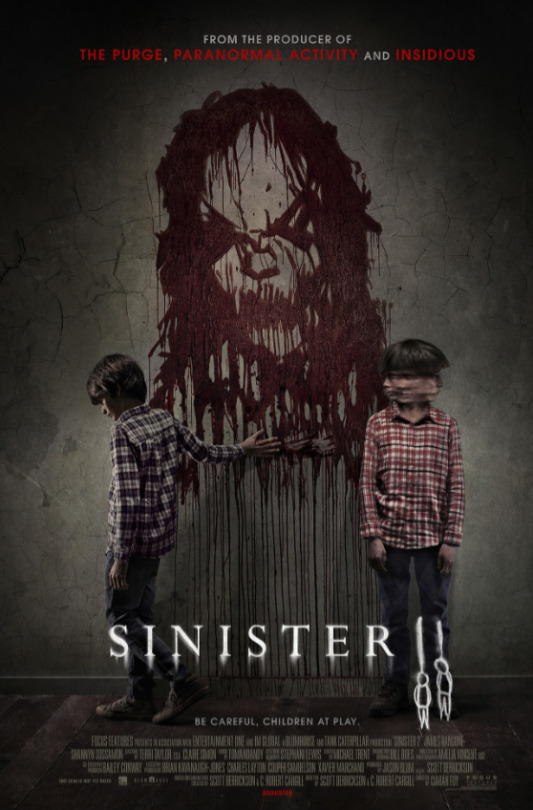


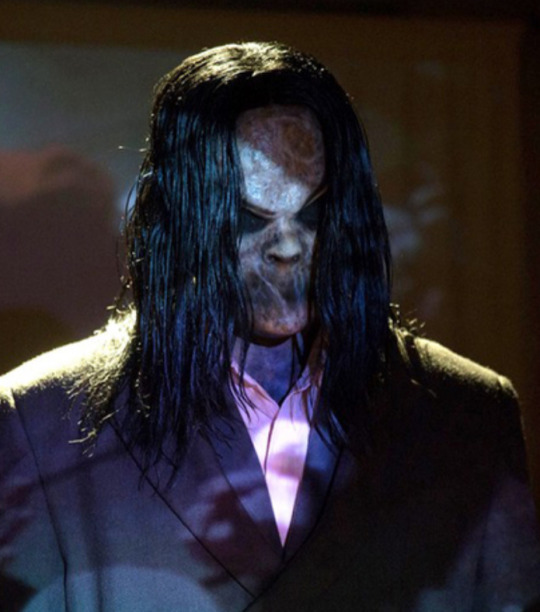
When experimenting with the dripping technique recently, involving myself spraying water onto wet paint in order to lift the base and create shapes, the finished result reminded me of the front cover of this movie. The cover of this horror movie depict the face of Mr. Boogie on the wall drawn with what looks like blood. The imagery is ambiguous and very sinister leaving drip marks much like the works i have created. This movie is very scary, even for me and i think, subconsciously i thought about the imagery in this movie when creating a lot of my works without realising. Therefore, without realising, i was influenced heavily by the imagery within the movie ‘Sinister’.
0 notes
Text
Meriam Awada: visual inspiration
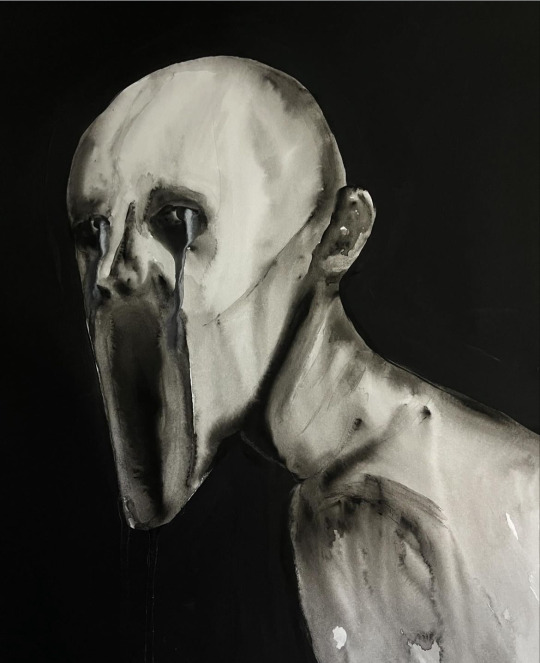
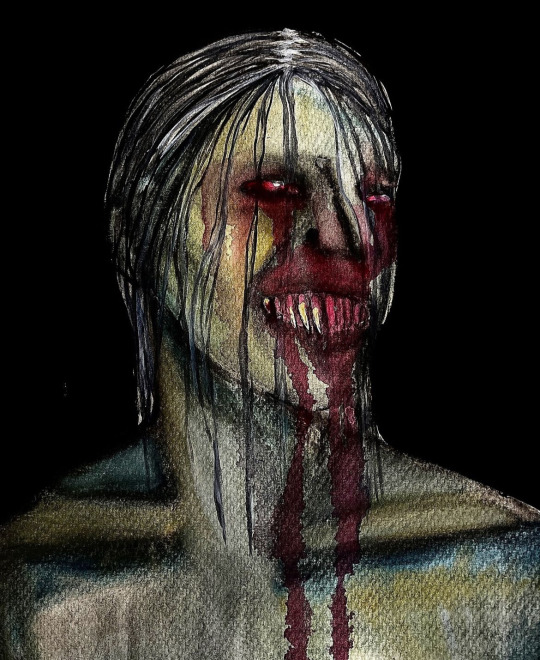
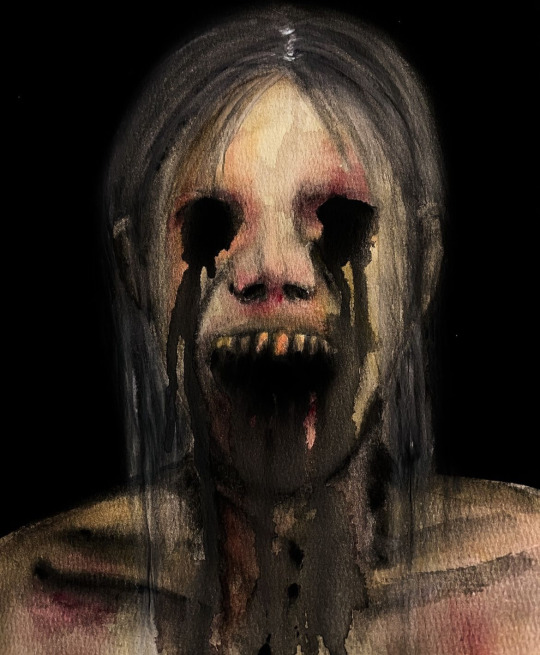
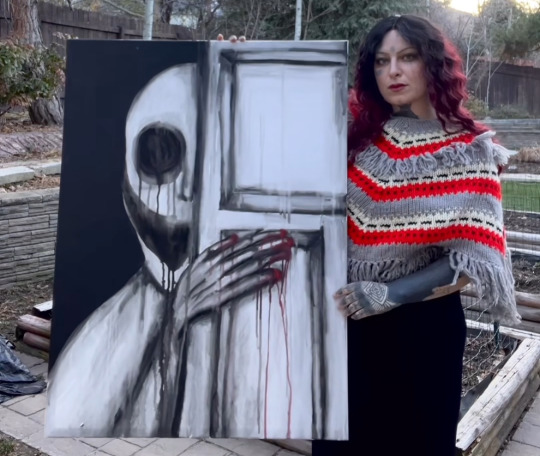
I came across this artist on Instagram and I thought certain techniques and sinister imagery conveys concepts and ideas similar to my work. These artworks also have a certain fluidity that I am drawn to as I adopt similar techniques when creating my work. I felt it was important to include this in my research as I created my work not knowing about this artist, however we clearly have similar creative minds. This was nice to see and find an artist that conveys similar ideas in their work.
0 notes
Text
Degree Show Proposal:
Emma smyth Degree Show Proposal
4th year BA (HONS) CAP
I aim to display my 10 paintings in an unconventional way whilst drawing attention to the sinister and ambiguous nature of my work. I will arrange my un-stretched paintings slumped on top of wooden stands that I have painted black and assembled. Some paintings that I have created on boards will have hinges attached to them allowing me to screw several of my paintings onto one stand, a street signpost idea. This will be displayed within the exhibition space in a way that allows the audience to walk around and engage with, almost creating an immersive installation experience for the viewer. My stands will hopefully be arranged on the floor space (4.5meters long x 3 meters wide). Therefore, I will not need walls to display my work. I aim to do this as it will allow and almost force the audience to walk around or amongst my work to reach other people’s work. There will be a reasonable distance between each stand allowing possible wheelchair users to interact and move safely around my work. I would like 1 x standing white plinth that will be situated in-front of my installation in order to display my business cards and stickers.
This is a rough sketch that visualises my plan:

0 notes
Text
Installation Art
-Installation art was pioneered in the 1970s.
- Installation art is the name given to mainly three-dimensional art work that has been displayed in a site specific area.
-Some installation art is temporary and others are permanent.
- Creates an intimate relationship between artwork and viewer as the are able to engage with and at times time more in and around the work.
-Different to land art, Intervention art and Public art, however, all these types of art have similarities.
- Within installation art it is common for the viewers thoughts and engagement to be more important than certain aspects of the artwork.
-This type of art is known for surprising the audience and engaging the viewers.
- It is not about what the art visually conveys, but instead what it communicates to the audiance.
-changing the audiences subjective thoughts towards the installation is an integral part of what the artist wishes to achieve.
- Installation artists do not focus on singular concept.
-This type of art has pushed the boundaries of what is considered art.
- It is difficult to decide the overall monetary value of installation art as it is challenging to collect and sell.
-If one wants to sell or by the artwork it causes challenges in terms of determining how it will be dismantled and reinstalled, which in turn may adjust the artworks value and meaning.
Key Artists:
-Marcel Duchamp.
-Damien Hirst.
-Judy Chicago.
-Sol LeWitt.
- Nam June Paik.
-Tracey Emin.
-Yayoi Kusama.
-Richard Serra.
-Dorothea Tanning.
- Ai Weiwei.
-Doris Salcedo.
-Jean Tinguely.
-Niki de Saint Phalle.
-Edward Keinholz.
Influences of Installation Art:
- This type of art was inspired and pioneer due to the combination of conceptual, theatrical, site and time specific works created by a number of artists involved with many movements.
-Marcel Duchamp’s toilet seat became “fine art” due to its plain and straight forward meaning. Duchamp’s radymades became a precursor to installation art and the avant-garde Dadaist movement. Their aim was co evoke conversation with their art rather than focusing on an aesthetically pleasing appearance to the artwork.
-Spatialism- movement, sound, sight, space, motion and time conveyed through aspects of art.
- The theatre has had a major influence in installation art.
- performance artist Gutai group from Japan staged a large performance that included multimedia.
-Allan Karoo created an installation piece that involved objects of art being curated throughout the whole gallery space.
-Yves Klein was also a major figure within the Installation art movement.
- the term “installation art” started being used during the 1970s.
-displaying works unconventionally whilst also focusing on the reactions and experiences experienced by the viewers.
- during the 1970s, Bruce Nauman’s, as well as Vito Acconci’s artworks evoked discomfort within the viewers, therefore both artists focused on the audiences reactions and emotions towards his works.
- audience direct involvement also became a part of installation art, Carsten Holler and Rosemarie Trockel and their House for Pigs and People (1997) is an example of this.
-from the 2000s installation art began involving lots of technology. Bruce Nauman’s Raw Materials (2004) and Maurice Benayoun’s Brain Factory (2016) are examples of where this can be seen.
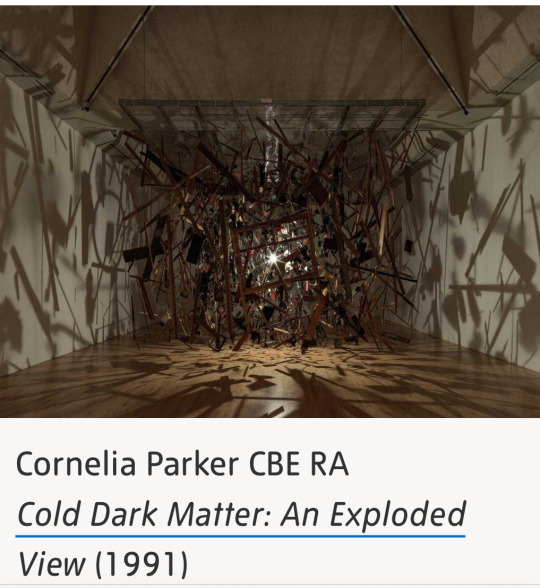
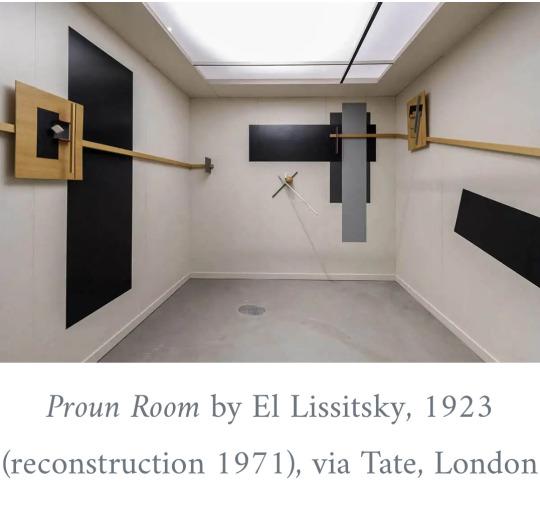

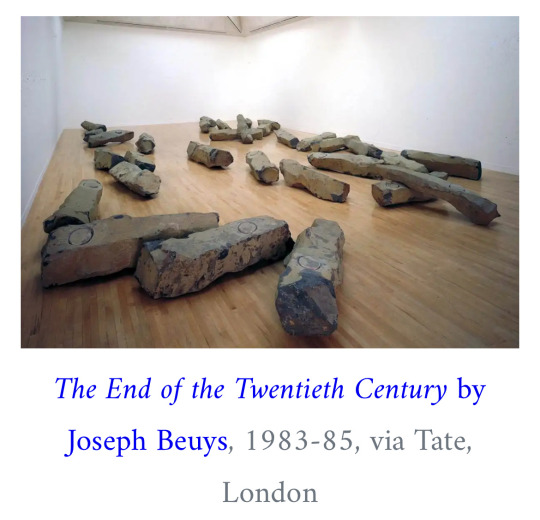
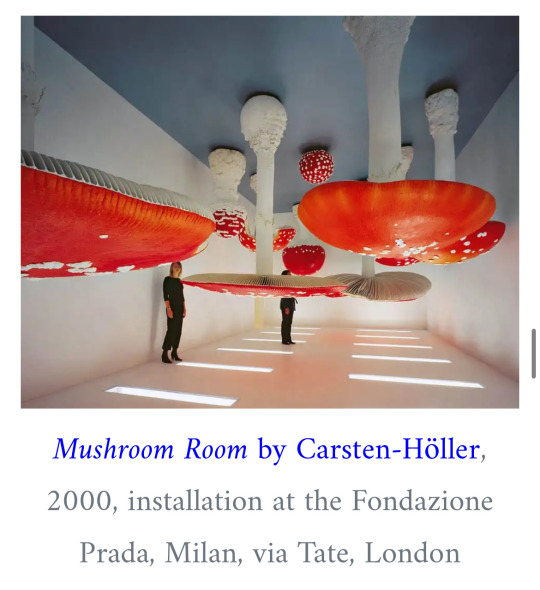

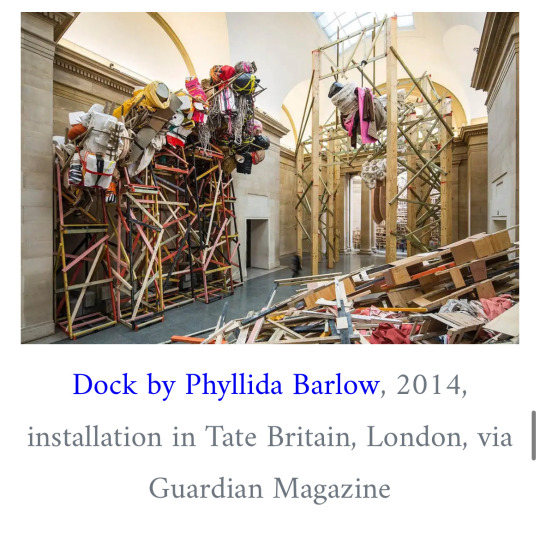
How Does this relate to my work?:
I have decided to arrange and display my paintings in an unconventional way by combining sculpture and paintings to create and installation piece. For my degree show I aim to have built up to 10 wooden stands that i can slump and display my canvas paintings over. I will arrange the stands with the paintings in away that will force the viewer to engage with if wanting to reach and engage with other peoples work. The viewer can simply walk around the installation or in and through it. The most important thing for me to consider with my work and the arrangement, is how the audience will engage with and react to my work. I want my audience to look up close at my paintings, but also to feel uncomfortable with the ambiguous and sinister forms that I will create.
0 notes
Text
Katharina Grosse:
-Born in Freiberg im Breisgau, Germany.
-The artist began painting from a young age. Grosse enjoyed experimenting with colour and how the light combines with the paint.
-Grosse is well known for her situ paintings.
-Grosse juxtaposed her paint colours, techniques, angles of her brushstrokes and brushstrokes as a whole.
-The artist would decorate hallways and staircases with elaborate artificial colour.
-Grosse at times uses a spray gun to create her works.
-In the late 1990s and early 2000s, Grosse began creating extreamly large works with a wide range of mediums.
-The artist began conveying and exploring liquidity within her artwork.
-In 2005 Grosse hung two very large pieces of canvas on a wall within Palais de Tokyo, Paris. One of the canvases were already painted on and the other was blank.
-The artist believes that there is no difference between painting, sculpture and architecture.
-Grosse creates armatures using polyurethane, Styrofoam, and cast-metal for her paintings.
-Untitled Trumpet was displayed in the Biennale di Venezia, as well as the Museum Wiesbaden in Germany during 2015.
-In some cases, Grosse has draped very long lengths of canvases from the ceiling to the floor adding dimension to her work, in turn creating an even more immersive experience for her audience.
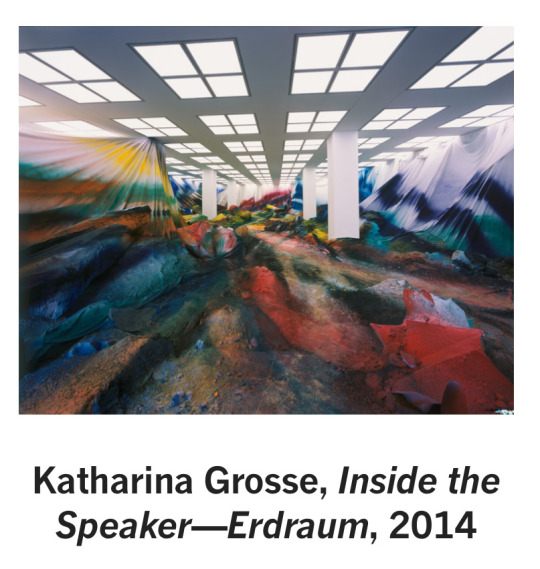

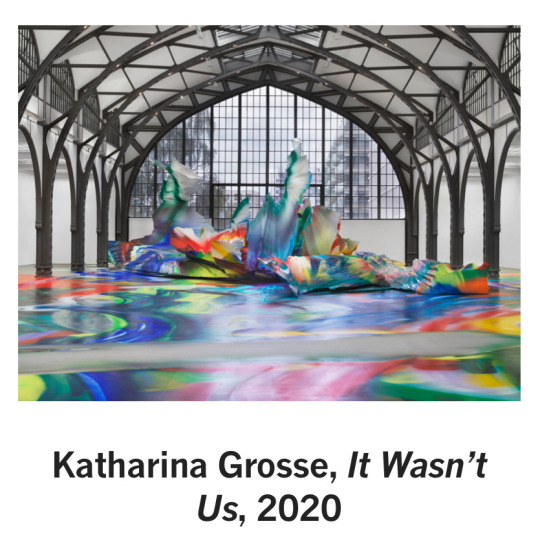
How does this relate to my work?:
Much like Grosse I will be displaying and arranging my paintings in an unconventional way instead of displaying them on stretched canvas hung on a wall. I will be blurring the lines between painting, sculpture and instillation as I will build wooden stands that will support my paintings. The canvases will by slumped/draped over the stand creating an uncanny and ambiguous form. By allowing my paintings to slump and drape on the stands, this will hopefully create a sense of fluidity much like Grosse's work where her work is hung and draped from floor to ceiling, drawing attention to and emphasising the fluidity of the paint marks made.
0 notes
Text
Francis Bacon:
• Francis Bacon was an Irish- British painter.
• Bacon was born in October the 28th, 1909 in Dublin, Ireland
• The artist died in April the 28th, 1992 in Madrid, Spain.
• Bacon was involved in expressionism.
• Many of his works were iconic images of wounded and mentally affected people post-war.
• The artist focused on surrealism, film, photography, and old master's techniques and ways of working.
• Distinctive style that was recognised by many in the 1940s and 1950s.
• Figurative portraiture work that depicts occupied bars and clubs within the Soho neighbourhood.
• Many of Bacon’s works have violent imagery that is distorted within the work.
• Bacon was one of Britain’s most successful painters of the 20th contrary.
• After Bacon died, he was known by many as one of the world's most important painters.
• The artists communicates emotions very powerfully through his paintings.
• Four Figures at the Base of a Crucifixion (1994) by Francis Bacon influenced many of his other works.
• The artist found a mature style in the late 1940s, as Bacon moved from a surrealist style to work inspired by depictions of motion seen in film and photography.
• Bacon evented new ways to convey movement within painting in order to bring painting and photography together.
• Bacon was inspired by Diego Velazquez’s Portrait of Pope Innocent X (c.1650) when creating is famous series of paintings, Screaming popes.
• Many artists began utilising other mediums within the artworld, however, Bacon continued to use painting within his practice whilst remembering its significance significance importance.
significance within the art world.
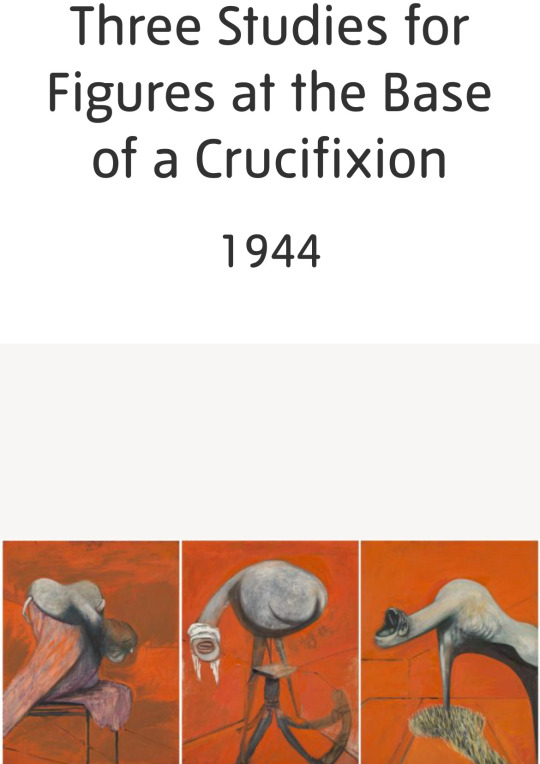

How will this influence my work;
- The main medium that i will utilise throughout my project will be painting.
- I aim to create a sense of movement within my paintings much like Bacon.
- Many may say my work is categorised as surrealism, which i will also research further.
- Many of my paintings may also be considered violent due to their imagery and lively brush strokes and other mark-makings.
0 notes
